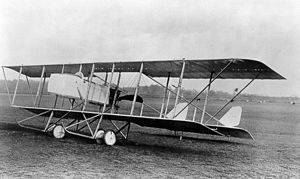The Maurice Farman MF.11 Shorthorn is a French aircraft developed before World War I by the Farman Aviation Works. It was used as a reconnaissance and light bomber during the early part of World War I, later being relegated to training duties.
| Farman MF.11 | |
|---|---|
 | |
| General information | |
| Type | Reconnaissance / Bomber |
| Manufacturer | Farman Aviation Works |
| Designer | |
| Primary users | French Air Force |
| History | |
| Introduction date | May 1914 |
| First flight | 1913 |
| Developed from | Farman MF.7 |
The Maurice Farman Shorthorn was the aircraft in which Biggles, Capt W.E. Johns' fictional character, first took to the air in "Biggles Learns To Fly".
Design and development
A pusher configuration unequal-span biplane like the earlier Farman MF.7, the MF.11 differed in lacking the forward-mounted elevator, the replacement of the biplane horizontal tail surfaces with a single surface with a pair of rudders mounted above it, and the mounting of the nacelle containing crew and engine in the gap between the two wings. The aircraft was also fitted with a machine gun for the observer, whose position was changed from the rear seat to the front in order to give a clear field of fire.
Its nickname in British service was derived from that of the MF.7 Longhorn, as it lacked the characteristic front-mounted elevator and elongated skids of its predecessor. The aircraft was also referred to by British pilots as the Rumpty.
From 1914, Farman built a modified version of the MF.11 for French army with a larger wingspan of 21 m (69 ft) and powered by a 100 hp Renault V-12 which was known as the Farman MF.12 or Type Armee XXVI.[1]
Operational history


On 6 September 1914 the first air-sea battle took place when a Japanese Farman MF.11 aircraft launched by the seaplane carrier Wakamiya unsuccessfully attacked SMS Kaiserin Elisabeth with bombs.[2]
The MF.11 served in both the British and French air services on the Western Front in the early stages of the war. It flew the first bombing raid of the war when on 21 December 1914 an MF.11 of the Royal Naval Air Service attacked German artillery positions around Ostend, Belgium.
The MF.11 was withdrawn from front-line service on the Western Front in 1915, but continued to be used by the French in Macedonia and the Middle East, while the British also used it in the Dardanelles, and Africa. The Australian Flying Corps (AFC), provided with the MF.11 by the British Indian Army, operated it during the Mesopotamian campaign of 1915–16.
Following its withdrawal from frontline service, the MF.11 continued to be used by the British in flight schools where it became known as the Rumpty[3] (or Rumpety). Despite its archaic looks, the MF.11 was regarded as a good aircraft for trainee pilots as its sturdy build meant that bad landings rarely caused damage to the undercarriage.[4]
Italy's Società Italiana Aviazione, a Fiat company, licence-built a number of MF.11s under the designation SIA 5 from early 1915, fitted with a fixed forward machine gun and a 74.5 kW (100 hp) Fiat A.10 engine.[5]
In 1916, the AFC also bought some MF.11s for training purposes.
Operators
- Australian Flying Corps
- No. 5 (Training) Squadron AFC in United Kingdom
- Mesopotamian Half Flight
- Central Flying School AFC at Point Cook, Victoria
- Hejaz Air Force - Two Farman MF.11s were obtained from Italy in 1921.
- Ukrainian Air Force - One aircraft only.

Surviving aircraft
- The Canada Aviation Museum has an MF.11 manufactured by Airco for the Royal Flying Corps and sent to Australia in 1917.[6]
- Farman F.11A-2, Royal Army and Military History Museum, Brussels, Belgium.
- Farman MF.11 Shorthorn (#CFS-15), RAAF Museum at Point Cook, Victoria, Australia.[7]
Specifications (Farman MF.11)
Data from British and Allied Aircraft Manufacturers of the First World War[8]
General characteristics
- Crew: 2 (pilot & observer/gunner)
- Length: 9.3 m (30 ft 6 in)
- Wingspan: 15.7 m (51 ft 6 in)
- Height: 3.1 m (10 ft 2 in)
- Empty weight: 654 kg (1,442 lb)
- Gross weight: 928 kg (2,046 lb)
- Powerplant: 1 × Renault 80 hp V-8 air-cooled piston engine
- Propellers: 4-bladed fixed-pitch pusher propeller
Performance
- Maximum speed: 116 km/h (72 mph, 63 kn)
Armament
- Guns: 1 × 7.62 mm (0.30 in) machine gun
See also
Related development
Related lists
References
Bibliography
External links
Wikiwand in your browser!
Seamless Wikipedia browsing. On steroids.
Every time you click a link to Wikipedia, Wiktionary or Wikiquote in your browser's search results, it will show the modern Wikiwand interface.
Wikiwand extension is a five stars, simple, with minimum permission required to keep your browsing private, safe and transparent.
